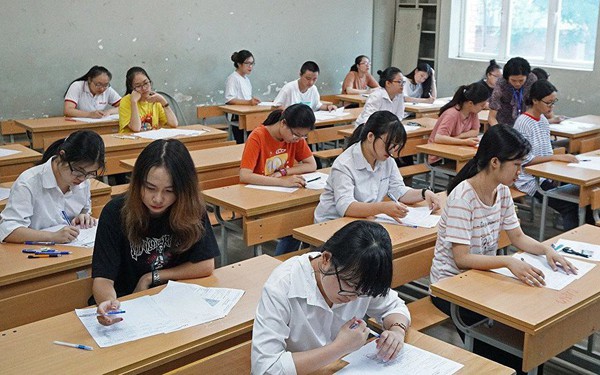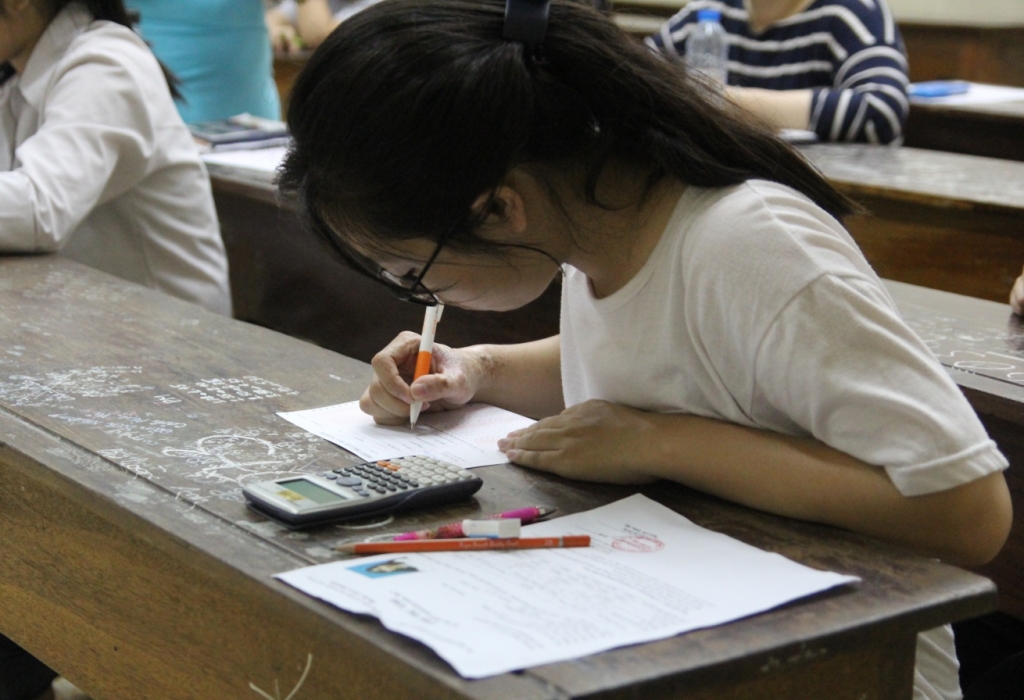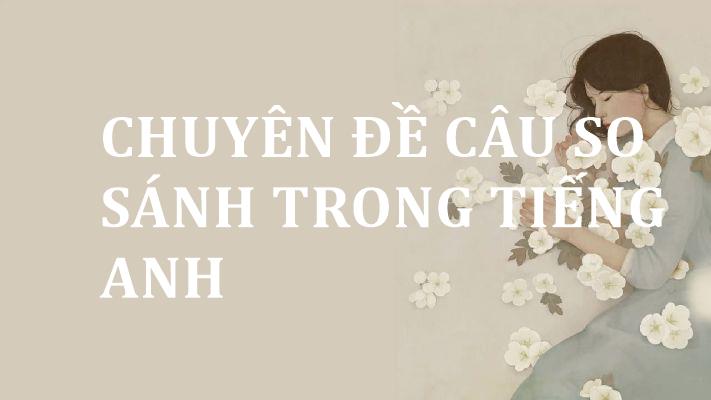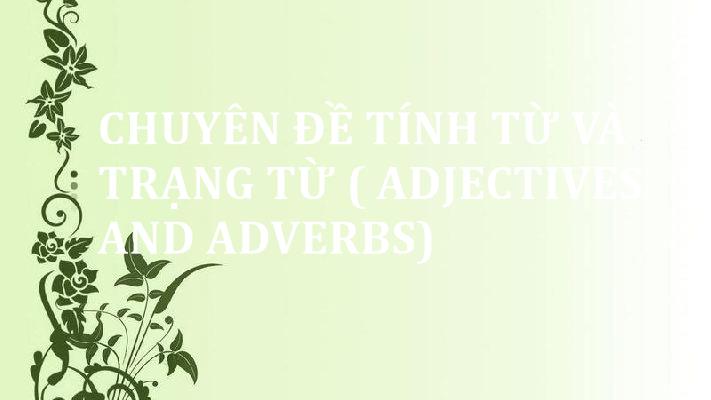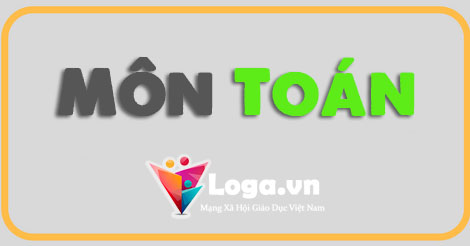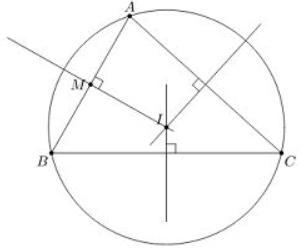KINH NGHIỆM LÀM BÀI TRẮC NGHIỆM DẠNG ĐIỀN KHUYẾT
Điền khuyết là một dạng bài luôn luôn xuất hiện trong đề thi tiếng Anh. Qua dạng bài này, học sinh được kiểm tra đánh giá kiến thức và luyện tập về ngữ pháp, từ vựng cũng như khả năng đọc hiểu của mình. Thông thường một bài sẽ có 5 câu, trong đó thường bao gồm 1 câu ở mức độ dễ, 2 câu ở mức trung bình và 2 câu ở mức độ khó. Để có thể làm tốt dạng bài điền khuyết, chúng ta phải áp dụng những tips khác nhau cho những dạng câu khác nhau.
Dưới đây là một số dạng từ điền khuyết thường gặp và một số tips làm bài hữu ích:
1. TỪ ĐỊNH LƯỢNG (many, much, a lot of, a/the number of, some, a few, a little, all, most,...): là từ dùng để chỉ số lượng của vật, số lượng toàn thể hay bộ phận.
Đa số học sinh dễ bị gài bẫy ở dạng điền từ này nếu không nắm chắc kiến thức về những từ được đưa ra trong đáp án. Dựa vào danh từ ở sau là số ít hay nhiều, đếm được hay không đếm được, đồng thời cũng phải biết được cạc sử dụng của mỗi định lượng từ.
- Some: dùng trong câu khẳng định.
Some + countable N (số nhiều) + V (số nhiều).
Some + uncountable N + V (số ít).
- Many/ much: dùng trong câu phủ định và câu nghi vấn.
Many + countable N (số nhiều) + V (số nhiều).
Much + uncountable N + V (số ít).
*Chú ý: too much và so many được dùng trong các câu khẳng định.
- A lot of/ lots of/ plenty of: dùng trong câu khẳng định.
A lot of/ lots of/ plenty of + countable N (số nhiều) + V (số nhiều).
A lot of/ lots of/ plenty of + N (không đếm được) + V (số ít).
- A great deal of (= much)/ a number of/ the number of:
A great deal of + uncountable N + V (số ít).
A large number of + countable N (số nhiều) + V (số nhiều).
A great number of + countable N (số nhiều) + V (số nhiều).
The number of + countable N (số nhiều) + V (số ít).
- A little và little/ A few và few:
A little (không nhiều nhưng đủ dùng) + uncountable noun + V (số ít).
Little (gần như không có gì) + uncountable noun + V (số ít).
A few (không nhiều nhưng đủ dùng) + countable noun (số nhiều) + V(số nhiều).
Few (gần như không có) + countable noun (số nhiều) + V(số nhiều).
- All:
All + countable N (số nhiều) + V (số nhiều).
All + uncountable N + V (số ít).
- Most of, all of, some of, many of:
Most/ some/ all/ many + noun (số nhiều) + V (số nhiều).
Most of, some of, all of, many of + the/ his/ your/ my/ this/ those... + noun (số nhiều) + V (số nhiều).
Ví dụ: Man cannot go on increasing numbers at the present rate. In the next 30 years, man will face a period of crisis. (1)______ experts believe that there will be a widespread food shortage[…]. One thing that man can do is to limit (2) ________ of babies born.
- A. Any B. Some C. More D.All
- A. a number B. the number C. an amount D.the amount
1. Đáp án: B.
Giải thích: Danh từ experts ở sau là danh từ đếm được số nhiều nên chúng ta sẽ loại được ngay đáp án A. Còn lại 3 đáp án B, C, D ta sẽ dịch câu này để có thể chọn được đáp án đúng nhất: Con người không thể tiếp tục gia tăng số lượng ở tỉ lệ hiện tại. Trong vòng 30 năm tới, con nhiều sẽ đối mặt với thời kì khủng hoảng. Một vài chuyên gia tin rằng sẽ có sự thiếu hụt lương thực rất lớn.
2. Đáp án: B.
Giải thích: sau of là một danh từ số nhiều và có thể đếm được nên ta loại được 2 đáp án C và D (an/the amount of + uncount. N). Để loại tiếp đáp án còn lại, ta sẽ dựa vào nghĩa của câu: Việc con người có thể làm được đó là hạn chế số lượng trẻ em được sinh ra. Vậy đáp án đúng nhất là B (a number of: một số, một vài/ the number of: số lượng).
2. GIỚI TỪ: Đây là một loại câu khó giúp phân loại học sinh. Loại câu này thường xoay quanh các cụm động từ có giới từ đi kèm. Vì vậy học sinh cần trang bị cho mình một lượng kiến thức về cụm động từ để dễ dàng giải quyết bài này. Bên cạnh đó, chúng ta cần phải nhớ một số cụm từ mặc định như: On the contrary, On the other hand in general, all in all, in/at the same way, for instance,…
Ví dụ 1: […]. And because people are staying single and living longer (often as widows), there may be more one-person households. (1) ____ the other hand, some people believe similar events happen again and again in history […]
1. A. In B. At C. On D. For
Đáp án: C.
Giải thích: On the other hand: mặt khác.
Dịch: Và bởi vì con người đang sống một mình và sống lâu hơn (thường là góa phụ), nên có thể sẽ có nhiều hộ gia đình đơn thân xuất hiện hơn. Mặt khác , vài người tin rằng những sự kiện tương tự diễn ra lặp đi lặp lại trong lịch sử[…]
Ví dụ 2: […] It is a time when families get together and celebrate with a meal. Many people make new plans (1)_________ the rest of the year. These plans are called New Year resolutions.
1. A. for B.from C. with D. by
Đáp án: A.
Giải thích: Cấu trúc: make plan for: lên kế hoạch cho việc gì đó.
3. TỪ VỰNG: Đây là một loại câu “khó nuốt” nhất trong dạng bài điền khuyết vì đôi khi chúng ta sẽ phải gặp những từ rất lạ và khó. Vì thế ta sẽ dùng phương pháp loại trừ và dựa vào ngữ cảnh của câu để chọn ra đáp án.
Ví dụ: […] Nowadays, not everybody finds tattoos acceptable. Some people think that getting one is silly because tattoos are more or less permanent. There is also some (1) __________ about catching a blood disease from unsterilized needles.
1. A. danger B. concern C. trouble D. threat
Đáp án: D.
Giải thích: Dịch ngữ cảnh: Ngày nay, không phải ai cũng chấp nhận những hình xăm. Vài người còn nghĩ rằng việc có một hình xăm thật là ngốc nghếch vì dù sao thì những hình xăm vẫn tồn tại vĩnh viễn . Ngoài ra cũng có những nguy cơ nhiễm bệnh về máu từ những kim xăm không được tiệt trùng. Vì vậy D là đáp án hợp lí nhất
4. LOẠI TỪ: Dựa vào loại từ của từ đứng trước hoặc sau chỗ trống cần điền để chọn ra được đáp án đúng.
- Từ cần điền là danh từ khi trước nó là một tính từ, động từ tobe hoặc từ định lượng
- Từ cần điển là tính từ khi đằng sau nó là một danh từ, đằng trước thường là một động từ tobe hoặc một số từ như seem/stay/become
- Từ cần điền là trạng từ khi trước nó là một động từ hoặc chỗ trống cần điền nằm ở đầu câu khi đóng vai trò như liên từ.
Ví dụ: Partly as a result, women make onle seventy-cent for every dollar earned by men. Morever, men routinely make more money even when education, experience and responsibilities are (1)_______________.
1. A. equally B. equality C. equal D. equalizing
Đáp án: C
Giải thích: Trước chỗ trống cần điền là một động từ tobe nên chúng ta loại được câu A (adv). Tiếp tục dịch ngữ cảnh của câu: Như một phần hệ quả, phụ nữ chỉ kiếm được 75 cent so với mỗi một đô la mà đàn ông làm ra, Hơn nữa, đàn ông thường làm ra nhiều tiền hơn ngay cả khi giáo dục, kinh nghiệm và trách nhiệm là như nhau. Vậy đáp án phù hợp nhất là C ( equality: sự bằng nhau, equalizing: làm cho bằng nhau).
5. BÀI TẬP:
Exercise 1:
Never say anything negative about past experiences, employers, or courses or professors. Always think of something positive about an experience and talk about that. You should also be (1)_____ If you are genuinely interested (2)_____ the job, let the interviewer know that.
One of the best ways to show you are keen on a job is to demonstrate that you have researched the organization prior to the interview. You can also (3)_____ interest by asking questions about the job, the organization, and its services and products. The best way to impress an employer is to ask questions that build your interview discussion. This shows you are interested and (4)_____ close attention to the interviewer. It is a good idea to prepare a few questions in advance, but an insightful comment based on your conversation can make an even stronger statement. At the (5)_____ of the interview, it is appropriate for you to ask when you may expect to hear from the employer.
Questions:
- A. enthusiast B. enthusiastic C. enthusiastically D. enthusiasm
- A. on B. for C. in D. with
- A. cover B. appear C. show D. conceal
- A. choose B. spend C. pay D. make
- A. finish B. final C. end D. close
Exercise 2:
Someone once has said that there are three kinds of people who are interested in sport: People who (1)_____ part, people who watch, and people who watch (2)_____ television. It’s very easy to make fun of stay-at-home sports fans but on the other hand, television does enable us to enjoy all kinds of (3)_____ events. We can watch a racing car overtake another, see a cyclist cross the finishing line, or enjoy the goals of our favorite football (4)______. The first time I watched a tennis match was on television, and I found it unexpectedly interesting. It’s not always easy to travel long distance to football grounds and television is a good solution. Of course, you can (5)_____ used to sitting indoors all the time, and this is dangerous. We should all try to keep fit, and have other interests and pastimes.
Questions:
- A. have B. make C. take D. get
- A. with B. on C. by D. from
- A. future B. the C. athlete D. sports
- A. group B. band C. class D. team
- A. or B. is C. which D. get
Exercise 3:
Parents and teachers are always making (1)_____ between the time when they were children and the present generation. They say everything was better than it is today, especially in education. (2)______, they say they used to work much harder in school, and that nowadays, we aren’t very interested. I disagree, because we spend hours everyday doing homework after our lessons or (3)_____ for exammination. I wonder (4)_____ our parents really had to study so much after school everyday. In my opinion, it is no exaggeration to say we have forgotten how to play. I think one reason why kids (5)_____ in class is because they need to get rid of stress.
Questions:
- A. comparison B. comparative C. compare D. comparatively
- A. As a result B. Therefor C. For example D. Nevertheless
- A. relearning B. revising C. resitting D. redoing
- A. why B. if C. that D. what
- A. misunderstand B. misdirect C. miscarry D. misbehave
Exercise 4:
According to sociologists, there are several different ways in which a person may be recognized as the leader of a social group in the United States. In the family, traditional cultural patterns confer leadership on one or both of the parents. In other cases, such as friendship groups, one or more persons may gradually (1) ______ as leaders, although there is no formal process of selection. In larger groups, leaders are usually chosen formally through election or recruitment.
(2) ______ of the common belief that leaders are people with unusual personal ability, decades of research have failed to produce consistent evidence that there is any category of “natural leaders”. It seems that there is no set of personal qualities that all leaders have (3) ______ common; rather, virtually any person may be recognized as a leader if the person has qualities that meet the needs of that particular group.
Furthermore, although it is commonly supposed that social groups have a single leader, research suggests that there are (4) ______ two different leadership roles that are held by different individuals. Instrumental leadership emphasizes the completion of tasks by a social group. Group members look to instrumental leaders to “get things done”. Expressive leadership, on the other hand, is leadership (5) ______ emphasizes the collective well-being of a social group’s members.
Questions:
- A. happen B. show C. emerge D. occur
- A. Whereas B. Although C. In spite D. Despite
- A. on B. in C. by D. at
- A. typically B. typified C. types D. typical
- A. which B. who C. what D. those
Exercise 5:
Everyone needs a home where they feel sheltered and safe. Today we live in modern flats and houses, (1)_____ have air-conditioning to keep us cool, and heating to keep us warm. There is electricity for lighting and supplies of gas or oil for the heating. Hot and cold water (2)_____ from the taps and dirty water disappear (3)_____ the drains. Many of our homes have balconies or gardens. In the past, people made their homes from materials that they found nearby. When we look at different houses we can tell how old they are from the materials used and the way they were built. It was different long (4) people did not have water in their homes and there were no electic lights. To keep warm, they sometimes made (5)_____ inside their homes. With a fire started they could cook their food and heat water.
Questions:
- A. where B. which C. whose D. who
- A. floats B. find C. flies D. flows
- A. up B. toward C. down D. on
- A. ago B. then C. back D. time
- A. flames B. food C. furnaces D. fires
Exercise 6:
We can communicate not only through words (1)______ through body language. Body language includes our posture, facial expressions, and gestures. Because body language is so important, you will want (2)_____ what yours is saying and how to interpret other people’s, too. Here are some examples of body language and its meaning. If your posture is slumped and your head is down, this could mean that you are sad or you lack (3)_____. If your posture is straight but relaxed, you are expressing confidence and friendliness. A smile is a sign of friendliness and interest. But people sometimes smile just to be polite. Friendliness and interest are expressed when a person’s eyes meet yours and then look away and meet your again. A person (4)______ doesn’t look away is expressng a challenge. Hand gestures can mean a person is (5)______ in the conversation.
Questions:
- A. but also B. and also C. but so D. and so
- A. know B. knowing C. to knowing D. to know
- A. confidence B. confide C. confiding D. confident
- A. whom B. who C. whose D. which
- A. interest B. interested C. interestingly D. interesting
Exercise 7:
The internet as truly transformed how students do their home work. (1)______ homework today still means spending time in the library, it’s for a different reasion. Rather than using books for research, students today are (2)______ to the internet to download enormous amounts of data available online. In the past, students were limited to their school’s (3)______ of books. In many cases, they got to the school library and found out that someone had already taken the books they needed. Nowaday, such inconvenience can be avoided since the internet never runs out of informaton. Students, however, do have to (4)______ sure that the information they find online is true. Tachers have also benefited from the homework which is done on the internet. They do not need to carry students’ papers around with them anymore. This is because online (5)______ allow students to electronically upload their home work for their teachers to read and mark. Of course, this also means that students can no longer use the excuse that the dog ate their homework!
Questions:
- A. For B. But C. While D. Because
- A. connecting B. looking C. searching D. linking
- A. select B. selection C. selective D. selectively
- A. do B. make C. get D. come
- A. systems B materials C. sources D. structures
Exercise 8:
School exams are, generally speaking, the first kind of tests we take. They find ound (1) ______ much knowledge we have gained. But do they really show how intelligent we are? After all, isn’t it a fact that some people who are very successful academically don’t have any common sense?
Intelligence is the speed at which we can understand and react to the new situations and it is usually tested by logic puzzles. (2) ______ scientists are now preparing advanced computer technology that will be able to “read” our brains, for the present tests are still the most popular ways of measuring intelligence.
A person’s IQ is his intelligence (3) ______ it is measuared by a special test. The most common IQ tests are run by Mensa, an organization that was founded in England in 1946. By 1976 it had 1.300 members in Britain. Today there are 44.000 in Britain and 100.000 worldwide, (4) ______ in the US.
People taking the tests are judged in relation to an average score of 100, and those (5) ______ score over 148 are entitled to join Mensa. This works out at 2% of the population.
Questions:
- A. what B. how C. which D. why
- A. Although B. Until C. Despite D. Because
- A. how B. as C. that D. so
- A. enormously B. highly C. considerably D. mainly
- A. which B. whom C. why D. who
Exercise 9:
Kindergarten is a fun place (1) ______ young chilren learn. In some special kindergartens, children learn outside most of the day!
Some kindergartens are (2) ______ the forest. In these “forest kindergartens”, children play freely. They’re out side in all kinds of weather. At forest kindergartens, children learn by climbing trees and picking fruit. They can also learn about and (3) ______ animals. For example, they collect chicken eggs and feed baby mice.
Little Flower Kindergarten is in Dong Nai, Vietnam. At this school, children learn about farming. They also learn it is important (4) ______ healthy food. They grow vegetables in gardens – on the roof! They eat the vegetables they grow in their lunches.
At Fuji Kindergarten in Tokyo, Japan, trees grow inside the building! The classroom windows and sliding doors (5) ______ open to the ouside most on the year. The roof is a big, wooden circle. Children love to play and run on it.
Questions:
- A. why B. when C. where D. which
- A. at B. in C. on D. by
- A. take care of B. take over C. take on D. take after
- A. to eat B eating C. eat D. eaten
- A. make B. stay C. do D. be
Exercise 10:
Any change in one part of an ecosystem can cause changes in other parts. Droughts, storms and fires can change ecosystems. Some changes (1) ______ ecosystems. If there is too little rainfall, plants will not have enough water to live. If a kind of plant dies off, the animals (2) ______ feed on it may also die or move away. Some changes are good for ecosystems. Some pine forests need fires for the pine trees to reproduce. The seeds are sealed inside pinecones. Heat from a forest fire melts the seal and lets the seeds (3) ______ . Polluting the air, soil, and water can harm ecosystems. Building dams on rivers for electric power and irrigation can harm eco systems (4) ______ the rivers. Bulldozing wetlands and cutting down forests destroy ecosystems. Ecologists are working woth companies and governments to find better ways of (5) ______ fish, cutting down trees, and building dams. They are looking for ways to get food, lumber, and other products for people withoud causing harm to ecosystems.
Questions:
- A. harms B. harmful C. harmless D. harm
- A. who B. where C. that D. when
- A. out B. in C. go D. fly
- A. on B. around C. over D. under
- A. catching B. holding C. carrying D. taking
6. ĐÁP ÁN:
Exercise 1:
- B. enthusiastic: (adj) nhiệt tình. Do vị trí này cần 1 tính từ (sau to be).
- C. in: “interested in” có hứng thú với cái gì đó.
- C. show: “show interest”- thể hiện sự quan tâm, hứng thú.
- C. pay: “pay attention to something”: chú ý tới cái gì đó.
- C. end:at the end of something: cuối cùng/ kết thúc của….
Exercise 2:
- C. take: “take part in something” – tham gia
- B. on: “on television” – trên TV
- D. sports: “sports events” – các sự kiện thể thao
- D. team: “football team” – đội bóng
- D. get: “get used to doing something” – tập quen với điều gì đó ở hiện tại
Exercise 3:
- A. comparison: Ở vị trí này ta cần một danh từ, “comparison” – sự so sánh
- C. example: Câu hỏi từ vựng “for example” – ví dụ.
- B. revising: Câu hỏi từ vựng “(to) revise” – ôn tập.
- B. wonder if: “wonder if” - băn khoăn liệu
- D. misbehave: “(to) misbehave” – hành động không đúng
Exercise 4:
- C. emerge: nổi bật lên
- C. In spite: Chỉ có “in spite” đi với “of” nên C là đáp án đúng
- B. in: “in common” – có gì đó chung/ giống nhau
- A. typically: bình thường, điển hình
- A. which: Ở đây ta cần một đại từ quan hệ thay thế cho danh từ “leadership” đã được nhắc đến phía trước
Exercise 5:
- B. which: Đại từ quan hệ chỉ vật, vừa làm chủ ngữ, vừa làm tân ngữ, “which” ở đây thay thế cho “modern flats and houses”.
- D. flows: “flows from” – bắt nguồn từ/ chảy từ.
- C. down:”down the drains”(thành ngữ) – đổ sông đổ biển, biến mất mãi mãi
- A. ago:”long ago” – rất lâu về trước, xa xưa.
- D. fires:”make fire” – đốt lửa
Exercise 6:
- A. but also: Cấu trúc “Not only… but also …” – không những … mà còn …
- D. to know:”(to) want + to + V_inf” – muốn làm gì.
- A. confidence: Sau động từ lack of ta cần một danh từ.
- B. who: Đại từ quan hệ, thay thế cho danh từ chỉ người, đóng vai trò là chủ ngữ
- B. interested: “tobe interested in” – hứng thú với điều gì
Exercise 7:
- A. while: Thể hiện sự tương phản giữa hai mệnh đề trong câu.
- A. connect: “connect to the Internet” – kết nối với mạng Internet.
- B. selection: sau sử hữu các ta cần 1 danh từ, “a selection of books” – sự lựa chọn sách.
- B. make sure: đảm bảo
- A. system: “online system” – hệ thống trực tuyến.
Exercise 8:
- B. how: “how much” – bao nhiêu.
- A. Although: mặc dù, until không dùng với mệnh đề ở thì hiện tại tiếp diễn, despite đứng trước danh từ nên loại B, C. Dựa vào nghĩa của câu ta chọn A thay vì D. (Tuy các nhà khoa học đang tiến đến công nghệ tiên tiến đọc được não người nhưng hiện tại các bài kiểm tra hiện tại còn rất phổ biến).
- B. as:Thử các đáp án chọn ra được đáp án phù hợp theo nghĩa. (IQ của một người là độ thông minh của người đó khi được đánh giá bởi một bài kiểm tra đặc biệt)
- C. considerably: Đáng kể, phần lớn.
- D. who: Đại từ quan hệ thay thế cho danh từ chỉ người, làm chủ ngữ trong câu.
Exercise 9:
- C. where: Ở đây là dùng where vì trong mệnh đề quan hệ không có giới từ “in” để mà có thể dùng which.
- B. in: Câu hỏi giới từ, “in the forest” – nằm trong rừng.
- A. take care: “(to) take care of” – chăm sóc.
- A. to eat:”It + be + important + to V_inf” – quan trọng để làm gì.
- B. stay: Câu hỏi từ vựng “(to) stay open” – luôn ở cửa.
Exercise 10:
- D. harm: Vị trí này cần một động từ làm vị ngữ cho câu, chủ ngữ là “some changes” – số nhiều, nên “harm” giữ nguyên mẫu.
- C. that: Đại từ quan hệ thay thế cho danh từ “the animals” nên dùng “that”.
- A. out:”let something out” – để cái gì đó rơi ra, tung ra. Câu trước có nói seeds ở trong pinecones, nên khi bị đốt cháy thì seeds sẽ rơi ra ngoài và mọc thành cây.
- B. around:”harm something” – gây hại đến cái gì, ở đây dùng “around” để khi khu vực xung quanh dòng sông bị ảnh hưởng, tránh nhầm lẫn với cụm động từ.
- A. catching: “catch fish” – đánh bắt cá

